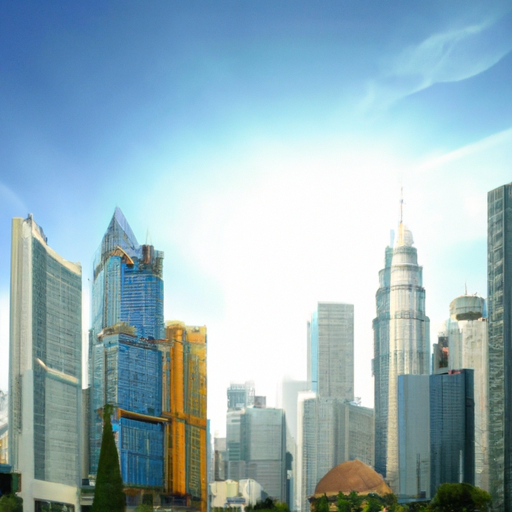Commercial Real Estate Industry Trends
In this article, we will explore the latest trends in the commercial real estate industry. From shifting investment preferences to the impact of technology, we’ll cover it all. You’ll discover how market forces are influencing property values, the rise of flexible workspaces, and the growing importance of sustainability in this dynamic sector. So, buckle up and get ready to delve into the exciting world of commercial real estate industry trends.

Table of Contents
Overview of the Commercial Real Estate Industry
Definition of Commercial Real Estate
Commercial real estate refers to properties that are used for business purposes, such as office buildings, retail spaces, industrial facilities, and multifamily properties. These properties are primarily focused on generating income through lease or rent payments from tenants. Commercial real estate is different from residential real estate, which is used for personal living purposes.
Importance of the Commercial Real Estate Industry
The commercial real estate industry plays a crucial role in driving economic growth and development. It provides spaces for businesses to operate, creates job opportunities, and contributes to the overall prosperity of communities. Commercial real estate also serves as a barometer of economic health, as demand for office and retail spaces reflects the strength of businesses and consumer activity.
Key Players in the Commercial Real Estate Industry
The commercial real estate industry involves various key players, each playing a vital role in the sector’s functioning. These players include real estate developers, investors, brokers, property managers, construction firms, and financial institutions. Developers are responsible for identifying opportunities, acquiring land, and constructing commercial properties. Investors provide the necessary capital to fund real estate projects. Brokers facilitate property transactions, while property managers oversee the operations and maintenance of commercial properties. Construction firms handle the design and construction of buildings, and financial institutions provide loans and financing for real estate projects.
Economic Factors Influencing Commercial Real Estate
Interest Rates and Financing
Interest rates have a significant impact on the commercial real estate industry. Lower interest rates can make financing more affordable, encouraging businesses to invest in real estate and expand their operations. Conversely, higher interest rates can make borrowing more expensive, dampening demand for commercial properties. The availability of financing options also affects the industry, as access to capital is necessary for developers, investors, and businesses to engage in real estate transactions.
GDP and Economic Growth
The state of the economy, as represented by the gross domestic product (GDP) and economic growth, influences the commercial real estate industry. Strong economic growth typically indicates increased business activity, leading to higher demand for office and retail spaces. Conversely, economic downturns can result in decreased demand and occupancy rates in commercial properties. Therefore, the performance of the commercial real estate market is closely tied to the overall health of the economy.
Unemployment Rates and Job Market
Unemployment rates and the state of the job market impact commercial real estate by shaping business expansion and contraction. Lower unemployment rates and a strong job market drive demand for office spaces and industrial facilities as businesses hire more employees and expand their operations. Conversely, higher unemployment rates can lead to reduced demand for commercial properties, as businesses may downsize or delay expansion plans. Understanding employment trends and job market conditions is crucial for assessing the potential demand for commercial real estate.
Consumer Spending and Retail Industry
Consumer spending patterns and the health of the retail industry also influence the commercial real estate sector. Retail spaces, such as shopping malls and storefronts, rely on consumer demand to attract tenants and generate income. Changes in consumer behavior, such as the rise of e-commerce, can impact the demand for physical retail spaces. Understanding consumer trends and the evolving retail landscape is essential for assessing the viability of retail real estate investments.
Technology and Digital Transformation in Commercial Real Estate
Impact of Technology on Property Listings and Transactions
Technology has revolutionized the way commercial real estate properties are listed and transactions are conducted. Online platforms and listing services have made it easier for potential tenants, buyers, and investors to search for available properties and access detailed information about them. Digital platforms have streamlined the property search process, enabling users to filter properties based on specific criteria and view virtual tours or images of the spaces. Additionally, technology has facilitated the automation of various administrative tasks, such as lease management and document signing, making property transactions more efficient.
Proptech Startups and Their Disruptive Innovations
The emergence of proptech startups has brought about disruptive innovations in the commercial real estate industry. Proptech, short for property technology, refers to the application of technology and digital solutions in the real estate sector. These startups have introduced innovative solutions in areas such as property management, data analytics, tenant experience, and smart building technologies. Companies specializing in proptech are transforming the way commercial properties are managed, improving efficiency, sustainability, and tenant satisfaction.
Use of Virtual Reality and Augmented Reality in Property Marketing
Virtual reality (VR) and augmented reality (AR) technologies have found applications in property marketing, particularly in the commercial real estate sector. VR allows users to experience realistic virtual tours of properties, giving them a sense of scale and presence. This technology enables potential tenants and investors to explore commercial spaces remotely, saving time and resources. AR, on the other hand, overlays virtual elements onto the real world, allowing users to visualize potential renovations, interior designs, or future developments on a property. VR and AR are valuable tools for marketing and showcasing commercial real estate properties to a wider audience.

Shifts in Office Spaces and Remote Work
Rise of Remote Work and Flexible Workspaces
The rise of remote work has led to a fundamental shift in the demand for office spaces. With advancements in technology and changing work culture, many companies are adopting flexible work policies that allow employees to work from home or choose alternative workspaces. This shift has resulted in reduced demand for traditional office spaces and an increased focus on flexible workspaces, such as coworking spaces and shared offices. These spaces cater to remote workers, freelancers, and small businesses, offering cost-effective alternatives to traditional lease agreements.
Evolution of Coworking Spaces
Coworking spaces have emerged as a popular option for professionals seeking flexible work environments. These spaces provide shared work areas, amenities, and networking opportunities. Coworking spaces cater to a diverse community of individuals and businesses, fostering collaboration and creativity. As the demand for flexible workspaces continues to grow, coworking spaces have evolved to offer specialized services and amenities, such as industry-specific workspaces, event spaces, and business support services. The rise of coworking spaces has disrupted the traditional office leasing model and transformed the way professionals work and collaborate.
Redefinition of Office Design and Amenities
The changing dynamics of office spaces have prompted a redefinition of office design and amenities. Traditional cubicle layouts have given way to open floor plans, collaborative spaces, and flexible furniture arrangements. Office designs now prioritize employee well-being, comfort, and productivity, incorporating elements such as natural light, green spaces, and ergonomic furniture. Amenities within office buildings have also evolved to include fitness centers, cafes, childcare facilities, and communal areas for socializing and networking. The focus on creating engaging and appealing work environments reflects the changing expectations of employees and companies in the modern workforce.
Changing Retail Landscape and E-commerce Influence
Impact of E-commerce on Brick-and-Mortar Retail
The growing popularity of e-commerce has had a significant impact on the brick-and-mortar retail industry. Online shopping has provided consumers with convenience, accessibility, and a wider range of options, leading to changes in consumer behavior and preferences. As a result, traditional retail stores have faced challenges, leading to store closures and changes in the demand for retail spaces. Retailers have had to adapt by embracing omni-channel strategies, integrating their online and physical presence, and reimagining the in-store shopping experience to remain competitive.
Adaptive Reuse of Retail Spaces
The decline of traditional retail has resulted in the adaptive reuse of underutilized or vacant retail spaces. Adaptive reuse refers to the repurposing of buildings or spaces for a different function than their original purpose. Retail spaces that were once occupied by department stores or large retailers are being transformed into mixed-use developments, including residential units, office spaces, entertainment venues, or community spaces. This adaptive reuse preserves the existing infrastructure and revitalizes communities by providing new economic opportunities and enhancing urban vibrancy.
Growth of Last-Mile Warehousing and Delivery Centers
The growth of e-commerce has fueled the demand for last-mile warehousing and delivery centers. Last-mile refers to the final leg of the delivery process, from the fulfillment center or warehouse to the customer’s doorstep. As online shopping continues to surge, companies are seeking strategically located warehouses and distribution centers to ensure efficient and timely delivery of goods. These facilities are typically situated in urban areas to minimize delivery time and costs. The growth of last-mile warehousing and delivery centers has impacted the demand for industrial real estate, particularly in urban and suburban locations.
Sustainable and Green Building Practices
Emphasis on Energy Efficiency and Environmental Sustainability
Sustainable and green building practices have gained prominence in the commercial real estate industry. There is a growing emphasis on energy efficiency, reducing carbon emissions, and minimizing the environmental impact of buildings. Developers and property owners are incorporating green building elements, such as efficient insulation, energy-saving lighting systems, and renewable energy sources like solar panels. These practices not only reduce operating costs but also contribute to environmental conservation by conserving natural resources and reducing greenhouse gas emissions.
Integration of Smart Building Technologies
Smart building technologies are being integrated into commercial properties to enhance energy efficiency, improve occupant comfort, and streamline building management. These technologies involve the use of sensors, data analytics, and automation systems to monitor and control various aspects of a building, such as lighting, temperature, and security. Smart building technologies enable real-time monitoring and adjustments, optimizing energy consumption and operational efficiency. Furthermore, these technologies enhance tenant experience by providing personalized settings and improving overall building performance.
Shift towards Net-Zero Buildings
Net-zero buildings, also known as zero-energy buildings, are becoming a significant trend in the commercial real estate industry. Net-zero buildings produce as much energy as they consume, primarily through renewable energy sources. These buildings combine energy-efficient design, insulation, and advanced technologies to minimize energy demands. Any remaining energy needs are met by on-site renewable energy generation, such as solar or wind power. Net-zero buildings not only reduce environmental impact but also offer long-term cost savings by significantly reducing energy expenses.
Investment Trends in Commercial Real Estate
Foreign Investments and Global Market Trends
Foreign investments play a significant role in the commercial real estate industry, as investors seek to diversify their portfolios and capitalize on global market opportunities. International investors are attracted to stable economies with strong growth potential and favorable investment climates. Countries with transparent regulations, political stability, and robust rental markets tend to attract foreign investments. Global market trends, such as the rise of emerging economies, urbanization, and demographic shifts, influence investment decisions and the allocation of capital in the commercial real estate sector.
Rise of Real Estate Investment Trusts (REITs)
Real Estate Investment Trusts (REITs) have gained popularity as a means for individuals to invest in the commercial real estate market. REITs are companies that own, operate, or finance income-generating properties and distribute a significant portion of their taxable income to shareholders in the form of dividends. REITs provide individual investors with an opportunity to gain exposure to the commercial real estate sector without directly owning and managing properties. They offer liquidity, diversification, and regular income, making them an attractive investment option for those seeking to invest in real estate.
Focus on Value-Add and Opportunistic Investments
Investors in the commercial real estate industry are increasingly focused on value-add and opportunistic investments. Value-add investments involve the acquisition of properties that have the potential for improvement or redevelopment, either through renovations, repositioning, or lease-up strategies. These investments aim to enhance the value of the property and generate higher returns for investors. Opportunistic investments, on the other hand, involve taking advantage of unique market conditions or distressed properties to generate substantial returns. These investment strategies require specialized expertise and a deep understanding of market dynamics and property potential.
Impact of COVID-19 on the Commercial Real Estate Industry
Changes in Demand for Office Spaces
The COVID-19 pandemic has had a significant impact on the demand for office spaces. Remote work arrangements and social distancing measures have resulted in a decrease in office occupancy rates as companies have implemented work-from-home policies and downsized their physical office spaces. The prolonged pandemic has prompted businesses to reassess their office space requirements and explore flexible leasing options. As vaccination rates increase and businesses gradually return to the office, the future demand for office spaces may undergo transformations, with a potential shift towards hybrid work models and innovative office designs.
Acceleration of E-commerce and Industrial Property Demand
The pandemic has accelerated the growth of e-commerce, leading to an increased demand for industrial properties such as warehouses and distribution centers. The surge in online shopping has created a need for efficient logistics and fulfillment infrastructure to support the last-mile delivery process. Industrial real estate has become a sought-after asset class, attracting investors and developers looking to capitalize on the expansion of the e-commerce sector.
Shifts in Retail Real Estate Due to Social Distancing Measures
Social distancing measures and the temporary closure of non-essential businesses have significantly impacted the retail real estate sector. Many retail businesses, particularly those reliant on in-person foot traffic, have experienced financial challenges and store closures. The pandemic has amplified the need for retailers to adapt and implement omni-channel strategies, integrating their physical and online presence. Retail real estate owners and developers are exploring creative solutions, such as pop-up stores, curbside pickup options, and contactless shopping experiences, to accommodate changing consumer preferences and adapt to the new retail landscape.
Regulations and Policy Changes
Impact of Tax Laws and Incentives on Commercial Real Estate
Tax laws and incentives have a direct impact on the commercial real estate industry. Changes in tax codes, such as tax deductions for real estate investments, can influence investors’ decisions and overall market activity. Incentives, such as tax abatements or credits for specific types of developments, can stimulate investment in targeted areas or industries. Adequate knowledge of tax regulations and incentives is essential for real estate professionals and investors to optimize their financial strategies and maximize returns on their commercial real estate investments.
Zoning and Planning Regulations
Zoning and planning regulations play a crucial role in shaping the development and use of commercial properties. Zoning laws dictate the permitted uses, density, and building heights for different areas within a municipality. These regulations ensure that commercial developments are appropriately located and compatible with surrounding land uses. Planning regulations guide the process of land use and development, ensuring that commercial projects adhere to the municipality’s long-term vision and goals. Understanding and complying with zoning and planning regulations is essential for developers and property owners to secure permits and successfully execute their projects.
Emerging Sustainability Guidelines
There is a growing focus on sustainability in the commercial real estate industry, leading to the emergence of sustainability guidelines and certifications. These guidelines provide frameworks and benchmarks for developers and property owners to assess and improve the environmental performance of their properties. Certifications, such as LEED (Leadership in Energy and Environmental Design), provide third-party recognition of a building’s sustainability features and practices. Adopting sustainable design, construction, and operational practices not only benefits the environment but also enhances the marketability and value of commercial properties.
Future Outlook and Predictions
Emerging Trends to Watch in the Commercial Real Estate Industry
The commercial real estate industry is constantly evolving, and several emerging trends are worth watching. One such trend is the convergence of technology and real estate, with continued advancements in proptech, smart building technologies, and data analytics. The continued expansion of the e-commerce sector and changes in consumer behavior will also shape the demand for commercial properties in the future. Additionally, the increasing emphasis on sustainability and green building practices is expected to continue, driving the adoption of energy-efficient designs and renewable energy sources.
Anticipated Shifts in Market Dynamics
The future of the commercial real estate industry may see several shifts in market dynamics. The demand for flexible workspaces is expected to persist as companies embrace hybrid work models and prioritize adaptable office spaces. The retail sector may witness a transformation, with a focus on experiential retail, curated shopping experiences, and community-driven spaces. Technology will continue to play a crucial role, with innovations in artificial intelligence, automation, and robotics influencing property management and tenant experiences. Changes in demographics, urbanization patterns, and global market trends will also shape the commercial real estate landscape in the coming years.






